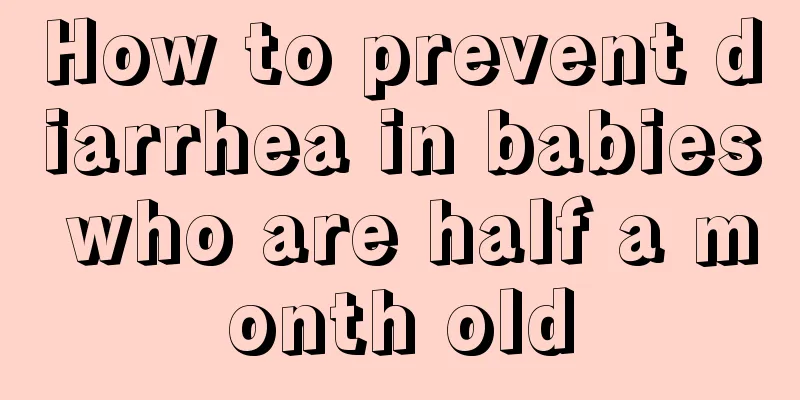How to correct the pigeon-toed walking of a one and a half year old baby

|
Some children start to walk with their feet turned inward when they are one year old, which makes their parents particularly worried. They are afraid that their children will walk very ugly when they grow up. Therefore, in order to solve this problem as quickly as possible, many parents want to learn about the method of correcting the inward-turned walking of one and a half year old babies. In order for you to understand it as quickly as possible, please read the detailed introduction below. I hope you can correct your child as soon as possible. How to correct the baby's pigeon-toed walking? If his feet are always pointed inwards and you think this walking posture is really indecent, in addition to letting your child sit, stand, walk, and run in the correct posture, you can use the following methods: 1. Have the child walk in step, and have an adult count commands while the child walks slowly to the beat. The number of exercises, steps and time per day can be determined step by step according to the degree of the child's gait deformity and the length of time it has been formed, and should be adjusted accordingly. 2. Straight-line stepping method. Draw two straight lines on the ground with a spacing of about 10 to 15 cm. Let the child walk back and forth on the straight lines on his toes and heels, with the pace increasing from slow to fast. If you train consciously like this and persist in it, the effect will be very good. 3. Straight-line running method: Pull a bright plastic belt on the ground or draw a straight line with colored chalk, let the child stand with his feet parallel on both sides of the straight line, and let the child run along the straight line under the guidance of an adult. Do not let the child run with his feet splayed. In addition, to correct pigeon-toed feet, you can kick shuttlecock with the outside of your foot. When the footsteps are corrected, the child's normal walking will return to its original state. At this time, you should always pay attention and remind your child in time. 4. Parents can let the baby lie flat on the bed after the baby takes a bath every night or before going to bed, and then put the baby's legs together to see if the baby's feet are still turned inward. If not, then the baby's walking posture is not good, which can be slowly corrected when the baby grows up. If the baby's feet are still turned inward when lying flat, the parents can hold the baby's left ankle about one finger width below the ankle bone with the left hand, hold the baby's toes with the right hand, gently bend them outward with even force, and then gently push the toes upward, taking turns with both feet, and do it 200 times a day. As long as the baby cooperates, you can do it at any time. 5. If your baby is calcium deficient, you need to supplement calcium. Prevent skeletal deformities in children (bow legs, X-shaped legs, spinal curvature, etc.) and do not force children to sit, stand or walk. It is best to place your baby in the prone position 2-3 times a day with his head elevated so that his chest can expand. On the basis of the above treatment, attention should be paid to diet, and egg yolks, animal livers, vegetables and fruits rich in calcium and phosphorus should be added appropriately. For example, jujube and hawthorn are high in calcium, while oranges and bananas are rich in phosphorus. For chest deformity, you can do exercises such as lying on your stomach and raising your head and expanding your chest. Lower limb deformities can be treated with muscle massage (massage the lateral muscle groups for O-shaped legs and the medial muscle groups for X-shaped legs) to increase muscle tension and assist in the recovery of deformities. 6. After the child is 4 years old, if he still has severe inward-turned feet, his knees will hit each other when walking or running, making him prone to falling. Or the degree of inward turning of one foot is much more serious than the other foot. This may be an abnormal situation and you need to go to the hospital for examination as soon as possible and let the doctor help correct it. Depending on the severity, it may take 2 to 3 years or even longer. Therefore, the earlier your baby wears orthopedic shoes and orthopedic braces, the better. Some serious cases cannot be corrected and still require surgery. The above introduces some methods for correcting the pigeon-toedness that occurs when the baby is about one year old. So if your child has this situation, you can use some of the methods introduced above to help your child correct the pigeon-toedness in a targeted manner. I believe that after a period of correction, your child will see a great improvement. |
<<: Care about every detail of your child
>>: Treatment of baby's pityriasis alba
Recommend
One week eight month old baby not talking
We all know that babies usually start to speak wh...
Baby coughs while sleeping
It is a very dry time now. Because every househol...
What should children with underarm odor eat? This food is precious.
For people with underarm odor, they need to pay a...
Newborn care and feeding?
Newborn babies need extra care in terms of care a...
Why do children have memory loss?
Children's poor memory is one of the things t...
What are the methods of matching baby diet nutrition?
The diet of infants and young children is a matte...
Neonatal polydactyly
Some newborns are born with deformed parts of the...
What to do if your five-year-old baby is grinding his teeth
Teeth grinding in a five-year-old baby is a big p...
What should I do if my baby's throat is a little red?
The baby's throat is a little red, which is a...
Who determines a child's IQ?
Parents all have high expectations for their chil...
How to give your baby a tummy massage
Many new parents, due to their lack of feeding ex...
What is the matter with baby hypoallergenic milk powder
Many babies have physical allergies. Babies with ...
What causes babies to cry at night?
Many mothers will find that their children often ...
What can’t babies eat when they have abdominal distension? Avoid foods that are difficult to digest
If your baby has symptoms of abdominal distension...
One and a half year old baby is particularly naughty
It is normal for children to be naughty. Many par...









